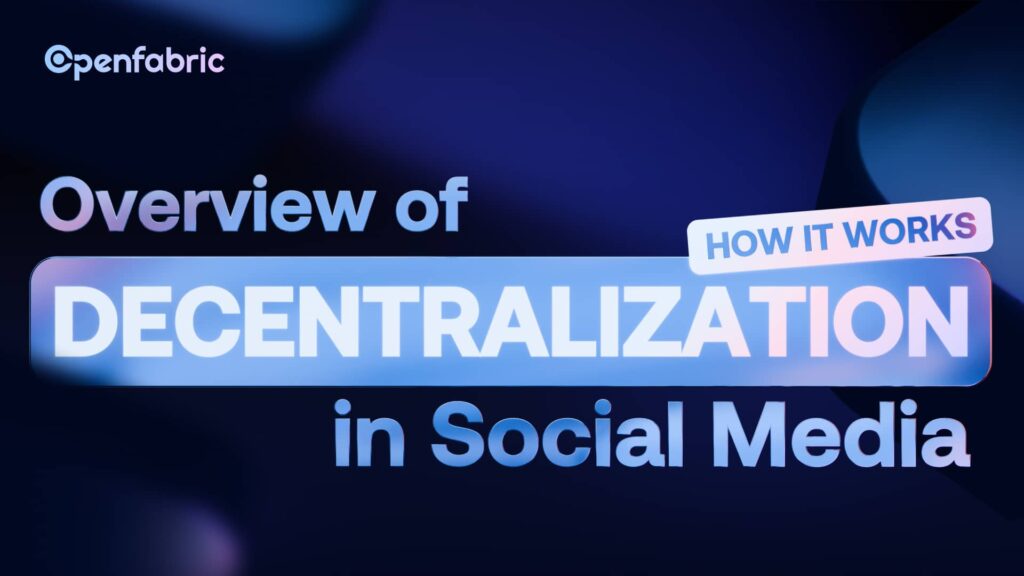
August 9, 2024 9 minutes read
Overview of Decentralization in Social Media: How it works.

Social media has come a long way since the early days of Facebook. However, as the years go by various trends emerge that are gradually changing social media. In more recent times, decentralization in social media is causing a revolution in how we interact, share, and connect online.
What is decentralization?
Decentralization means spreading power, control, and data from a central authority to a network of people or nodes. This shift in thinking has big effects on social media, which big platforms like Facebook, Twitter, and Instagram have controlled for a long time.
People have criticized the centralized social media model for many problems. These issues have led more people to want different platforms that put user freedom, privacy, and safety first. To meet this need decentralized social media platforms have shown up. They offer a new way to interact online that’s more democratic, open, and community-based.
Decentralization in social media uses distributed technologies like blockchain, peer-to-peer networks, and federated systems to build platforms that can withstand attacks, adapt to changes, and resist censorship. These technologies help create decentralized networks where nodes across the system store and send data instead of a single central authority controlling everything.
Decentralization in social media has many upsides. For example;
- Decentralized platforms give users more say over their data letting them decide how to share their information and who to share it with.
- These platforms also boost diversity and inclusion by allowing people to set up niche communities and networks that cater to specific interests and identities.
But decentralization in social media also creates many challenges and limitations. Despite these challenges, the potential benefits of decentralization on social media make it an exciting field worth exploring.
As we continue to explore this topic, we shall find out what shape decentralized social media has taken today. We will also see its advantages and limitations, as well as potential use cases and applications for decentralized platforms.
Problems faced with Centralized Platforms
Nowadays, a small number of centralized platforms such as Facebook, Twitter, Instagram and YouTube have a strong foothold in the social media landscape. In the history of human society they are the most influential ones of their kind.
As a result, they have accrued billions of users worldwide but their dominance also brought about a litany of other problems, including:
- Ethical concerns (such as the exploitation of user data) were raised with data ownership and control: Centralized platforms have access to massive quantities of consumer information which they use for their benefit. This has called for questions concerning user’s privacy and data control.
- Censorship and moderation: The power to censor and moderate content is in the hands of centralized platforms. It has been said that this new era heralds both its own form or let form for digital censorship.
- Algorithmic Discrimination: it has been shown that algorithms used on central platforms not only regulate content but also maintain and propagate discrimination over time.
- Monopoly: In the social media realm centralized platforms have created no room for competition or innovation.
- Security threats: Centralized platforms are always in danger of a data breach, leaving personal information vulnerable to espionage and cyber attack.
Despite these issues, centralized platforms remain incredibly popular, and many users are deeply invested in their online communities and networks. However, the problems associated with centralized platforms have sparked a growing interest in decentralized alternatives.
Decentralization in Social Media Today
Decentralization in social media platforms means a bottom-up shift in our online communication altogether. These decentralized social media platforms, popularly known as DeSo, take data, control and decision-making out of the hands of giant, centralized tech companies and relocating them onto the blockchain through special contracts (decentralized applications). Through this, they hope to create a more democratic, transparent grassroots setting that is beneficial to everyone who participates in it.
Decentralization in social media platforms is based on a distributed network, where data is stored and transmitted across the nodes of a network rather than controlled by any one central authority.
We can already see this in some platforms such as;
- Mastodon: A decentralized microblogging platform, open source
- Diaspora: A distributed social network allowing users to host their own podcasts
- Steemit: The cryptocurrency-based social platform that integrates with a blockchain and rewards producers and curators of content
- LBRY: A decentralized video-sharing platform that uses blockchain technology to assist creators in financing their projects as well as protecting freedom of speech
Benefits of Decentralization in Social Media
Decentralization in social media has many benefits. The main benefits include:
User data ownership and control
On decentralized platforms individuals are in charge of their own data, meaning they can decide who gets to see it and for what purpose.
Privacy and security
Decentralized systems are harder to hack or break into than centralized ones. They rely on the goodwill of a large number of separate machines working together to store and send data.
Resistance to censorship and moderation bias
Decentralized systems are more resistant to censorship and bias in moderation. This is because decisions about content-review policies are made by the community as a whole rather than being imposed from above by one central authority.
Community-driven decision making
Decentralized platforms facilitate decision-making through community. In token-based systems or similar mechanisms, they allow users to participate in governance and decision making.
Innovation and creativity
Decentralized platforms can create innovation and creativity. For example, software developers can build new applications and services and use decentralized networks in their operations.
Freedom of expression
Decentralized platforms can advocate for freedom of expression. This is because people can send out their personal works of art or opinions and ideas without interference.
Transparency and accountability
Decentralized platforms promote transparency and accountability of users to track the flow of data or how decisions are made across networks.
By decentralizing social media, we will get a more democratic, transparent community and internet landscape. In this case, the potential of decentralized social media is to change how people interact and share online, as well make a more fair and just digital society.
Challenges and Limitations of Decentralization in Social Media
Although there are many advantages, decentralized social media also faces several challenges and constraints. Some of the key challenges are as follows:
Not user-friendly
Decentralized platforms need to be easily scalable and usable. At present, they often need a high degree of technical expertise to use well, which acts as an entry barrier for non-technical users.
It is not interoperable
Decentralized platforms are even harder to achieve interoperability with, making it difficult for users to communicate and share content across different platforms.
Legal challenges
Decentralized platforms are often found in legal gray areas. This may make them prone to regulatory and legal challenges as they are not necessarily operating within existing traditional legal frameworks everywhere.
Security challenges
Decentralized platforms may face entirely new security risks. Examples are cyber attacks and smart contract vulnerabilities.
Reluctance to adopt the new innovation
Decentralized platforms might have difficulty obtaining adoption as users may be unwilling to switch away from established centralized platforms.
Unstable source of funding
Decentralized platforms may have uncertainty about funding and achieving sustainability, since they rely on token-based models or community support.
Being aware of these challenges and limitations, we can work to overcome them and build more powerful, more scalable and more user-friendly decentralized social media networks alike.
Use Cases and Application of Decentralization in Social Media
Decentralized social networking holds great potential for many applications. Some examples include the following:
- Community-driven networks: By using decentralized media products, community-driven networks can be established. The users are in charge of creating and managing their own communities, and p2p transfer is encouraged. For example, Mastodon allows users to host individual communities and connect with other users.
- Niche Platforms: A decentralized social media environment can produce the development of niche networks tailored for specific interests and identities. LBRY is a video content creation and publishing platform that allows users to share content with other users.
- Decentralized data identity and authentication: Decentralized social media can allow its users access to tools that enable them to verify their information before engaging with it. Veramo is a decentralized data authenticator that works this way.
- Content creation and monetization: Decentralized social media opens up new possibilities for content creation, and can introduce models of monetization like token-based systems and decentralized marketplaces. For example, Steemit allows creators to create content, and rewards them.
- Social media networking: Decentralized social media can offer new forms of social networking and collaboration, such as decentralized project management and community-driven decision-making for projects outside an organization. For example, Matrix is a platform that enables secure decentralized networking between users.
As we explore these use cases and applications, we can release the full potential of decentralized social media. It will create new ways of online interaction, community building, and content creation.
The Future of Decentralization in Social Media: Openfabric AI Platform
Openfabric AI is a decentralized artificial intelligence platform for building and connecting decentralized AI applications. These include social media applications, content creation applications and so on.
Unlike other artificial intelligence platforms, Openfabric AI has a plethora of decentralized AI tools that find many tools in social media. Examples of such tools include:
Openfabric Influencer App
The Influencer App animates any face and makes it talk in sync with a selected audio. It has a complex process where it synchronizes the model’s face with the sound from the audio. Therefore, it creates a high resolution visual of a model talking.
Thus, you can animate photos and bring them to life which is a great way to engage your social media audience.
Artfabric AI App
This application uses simple prompts to create a high quality image that you want.
The good thing is, it only takes a few seconds and is mobile friendly. Therefore, you can unleash your inner picasso on the go, or in your room.
With the Artfabric AI App, you are your only limitation. However, it is of utmost importance that while using it, we must adhere strictly to the community guidelines.
Memefabric AI App
We all know that memes are one of the juiciest parts of social media. In fact, memes have become so juicy that “memers” are now paid to create memes.
With the Memefabric AI App, you can create funny memes in the comfort of your space. You can go a step further by participating in a blockchain-based meme contest and get paid in cryptocurrency.
Whatever you need memes for on social media, the Memefabric AI App has you fully covered.
3D model generator
This tool is used to create 3D models. These 3D models can be printed, but for social media you can use them to create a virtual environment for marketplaces, virtual events and creation of social media avatars.
Text-to-animation AI App
Social media is slippery, one day you could wake up and just start losing your followers. What keeps your followers is the kind of content you post. Therefore, your content must be engaging, informative and entertaining or at least two of these.
Although there is a need for these types of content, the actual process of creating them is easier said than done. This is where the Text-to-animation AI App comes into play.
With this AI App you can use simple text prompts to create animations for whatever you need them for on social media. It doesn’t only save you time and energy, it also saves you a lot of money.
Each of these AI Applications and tools find vast applications when it comes to decentralization in social media. Visit the Openfabric AI website to see step-by-step instructions on how to use these tools.
Conclusion
Decentralization in social media, when fully established, will bring about a radical change in the way social media is used. Users will have more control over their data, there will be more opportunities and innovation, and so on.
More interestingly, Openfabric has all the necessary tools and applications to bring about this radical change. With them also, is the potential to earn wisely through these tools.
Do not be left behind when the change comes.
Head on to our WEBSITE, and start exploring and applying these tools today!!!

